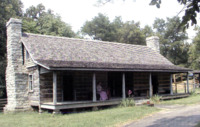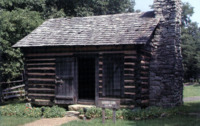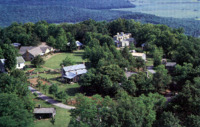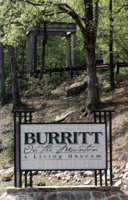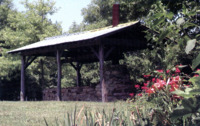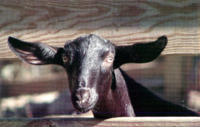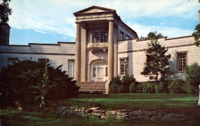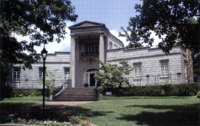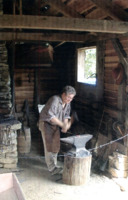
Browse Items (9 total)
Sort by:
-
Smith-Williams Log House
Back: Smith-Williams Log House at Burritt on the Mountain - A Living Museum (1900). The Smith-Williams house originally stood on the eastern base of Monte Sano Mountain. It is a typical home of a subsistence farm family in the hills of North Alabama in 1900. -
Gardiner Cabin at Burritt on the Mountain
Back: Gardiner Cabin at Burritt on the Mountain - a Living Museum (1850). The Gardiner Cabin originally stood in southern Madison County near the Tennessee River. A small one-room cabin, it is typical of slave housing in the Tennessee Valley. -
Aerial view of Burritt on the Mountain
Back: Aerial view of Burritt on the Mountain - A Living Museum with Jones Valley in the background. -
Arch at Entrance to Burritt on the Mountain
Back: Arch at entrance to Burritt on the Mountain - A Living Museum, Built by Dr. William Henry Burritt as the entrance to his retirement estate completed in 1938. -
Sorghum Furnace at Burritt on the Mountain
Back: Sorghum Furnace at Burritt on the Mountain - A Living Museum. Southern farmers boiled down the juice from their sorghum cane crops in furnaces to make a pure, amber colored syrup. In the late 19th century, sorghum was the most popular sweetener in the South. -
Brush Goat at Burritt on the Mountain
Back: Brush Goat at Burritt on the Mountain - A Living Museum. Historic breeds of animals typical on the farms of North Alabama in 1900 bring to life the experiences of our rural ancestors. The term Brush Goat simply refers to a mixture of two or more breeds. -
Burritt Museum on Monte Sano Mountain
Back: BURRITT MUSEUM on Monto Sano Mountain, Huntsville, Alabama. Situated on 167 acres of land, with one of the most scenic views in the beautiful North Alabama region. The Burritt Museum and its grounds contain countless items of local and national interest. -
The Burritt Mansion at Burritt on the Mountain
Back: The Burritt Mansion at Burritt on the Mountain - A Living Museum. Built by Dr. William Henry Burritt for his retirement home atop Round Top Mountain with a commanding view of the City of Huntsville and the Tennessee Valley. Completed in 1938, the house is insulated with 2200 bales of wheat straw. -
Blacksmith at work at Burritt on the Mountain - A Living Museum. Missile and Space Capital.
Back: Blacksmith at work at Burritt on the Mountain - A Living Museum. Living history interpreters perform the tasks of 19th century farmers in Burritt's Living History Program.
